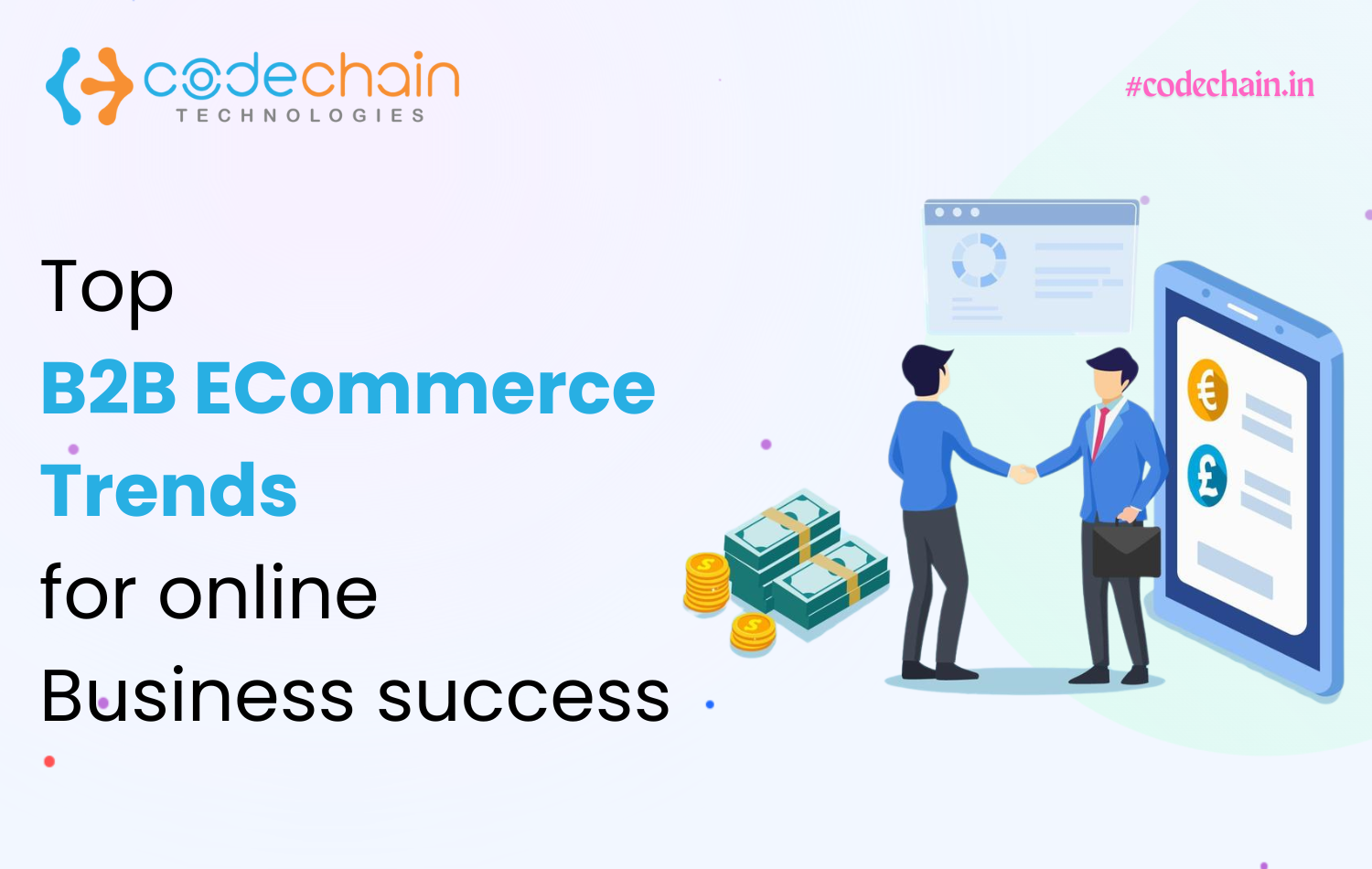
With a number of B2B ecommerce trends influencing the direction of the sector, 2024 looks to be a year of substantial innovation and change for those working in the B2B ecommerce area. A new generation of digitally savvy B2B customers is predicted to propel the US B2B sales to an astounding $3 trillion by 2027, while the global B2B ecommerce market is predicted to reach an astounding $20.9 trillion by 2024.
Traditional channels are no longer the exclusive option for these purchasers. The simplicity and customization people enjoy in B2C shopping are quickly matching their expectations. To thrive in this cutthroat environment, businesses require platforms that satisfy the expectations of contemporary consumers.
Whether you're upgrading an old B2B platform or creating a new one from the ground up, knowing these trends will help you satisfy the demands of today's astute corporate buyers.
B2B Ecommerce Trends For Your Business Success
Self-Service Purchase Options
- B2B buyers today expect self-service solutions' convenience and independence. Platforms that let customers do their own product research, inventory checks, order placement, and shipping tracking without contacting a salesperson will be given preference. This B2B e-commerce trend expedites decision-making and lowers purchasing friction.
- In addition to improving the customer experience for the increasing number of B2B buyers who want a self-directed purchasing process, it frees up your sales team to concentrate on more strategic projects. This strategy guarantees that a more effective, streamlined procedure benefits both buyers and sellers.
Using Generative AI to Improve Customer Experiences
- By providing cutting-edge solutions for content production, customer service, and tailored marketing, generative AI is revolutionizing business-to-business e-commerce. The impact is substantial, ranging from generative AI creating customized product descriptions to AI-driven chatbots answering intricate consumer inquiries.
- Product descriptions that adjust to the interests of each individual customer, highly effective personalized marketing content, and even AI-powered negotiating tools can all be created with generative AI. Workflows are streamlined, experiences are personalized, and your staff is free to focus on high-value interactions.
Payment versatility and Options
- Customers increasingly want a variety of payment methods, which is another development in b2b e commerce . It is crucial to incorporate solutions that are customized to client interests, such as net terms for existing accounts, ACH payments, and credit cards. In addition to meeting a range of financial demands, providing flexible payment plans encourages purchases, enhances cash flow, and forges closer bonds with clients.
- To make transactions even more convenient and appealing to business-to-business (B2B) buyers, think about including digital wallets, Buy Now, Pay Later (BNPL), and cryptocurrency payments. Offering a range of payment options gives customers the freedom to select the one that best meets their requirements. Therefore, it improves their shopping experience and raises your chances of winning their business.
B2C-Like Purchase Experience for B2B Buyers
The same degree of ease and customization that b2b in e commerce offers is now expected by B2B buyers. This includes user-friendly websites with personalized recommendations, straightforward navigation, and speedy checkout processes. Because they are accustomed to B2C buying advantages, B2B shoppers prefer platforms that put an emphasis on user-centric design. This entails placing a strong emphasis on a simple user interface and unambiguous product information.
This method improves user happiness while streamlining the purchasing process. In the end, this promotes client retention and repeat business.
Mobile-First Strategy
- A mobile-first strategy is crucial given the growing usage of mobile devices for work-related tasks. Making sure your b2b e commerce solution is mobile-friendly will satisfy buyers who are constantly on the go and enhance the user experience in general.
- Make your platform as mobile-friendly as possible. This entails features like voice search and mobile checkout for enhanced convenience, user-friendly mobile apps for purchasing while on the road, and responsive design that easily adjusts to any device.
Automation
- In order to streamline processes in B2B e-commerce, automation is essential. Businesses can greatly increase productivity and responsiveness by using automated solutions in a variety of areas, including order processing, inventory management, and customer service.
- It guarantees more seamless transactions by lowering operating expenses and minimizing errors. Furthermore, using AI-powered chatbots for customer support interactions allows for speedier question response, which raises customer satisfaction levels overall.
- Businesses can maximize their resources and free up their teams to concentrate on important projects by implementing these technology, strengthening client relationships and promoting long-term growth.
Strategies for Omnichannel Unified Commerce
- Success depends on delivering a flawless experience across all sales channels, including online, mobile, and physical. By integrating many touchpoints, an efficient omnichannel approach guarantees a seamless customer journey and real-time inventory visibility.
- B2B buyers of today anticipate a seamless experience across all platforms. You may offer a consistent brand experience by linking your platform with marketplaces, CRM systems, mobile apps, and online retailers. As a result, customers are more likely to trust and stick with your business, no matter how they choose to interact with you.
Expanding Reach with B2B Marketplaces
- b2b e commerce solutions marketplaces are growing in popularity because they give companies another way to connect with potential customers. In addition to giving merchants more visibility and sales opportunities, these platforms offer a vast range of goods and services, making it simpler for customers to compare and buy.
- Businesses can increase product exposure, draw in new clients, and take advantage of these platforms' competitive pricing power by integrating with pertinent marketplaces with ease.
Streamlined Repurchasing with Recurring Orders
- Recurring B2B transactions are common. Automated reordering systems and subscription models can streamline the buying experience for customers and guarantee a consistent flow of income for vendors. The demand for convenience and dependability in business-to-business transactions is met by this trend in e-commerce b2b .
- This saves them time and guarantees a steady supply chain by enabling B2B buyers to set up automated reorders for commonly requested commodities.
Data-Driven Decisions with Real-time Analytics
- Having access to real-time data and advanced analytics tools is essential for making informed business decisions. You may obtain important insights into customer behaviour, purchasing trends, inventory patterns, and operational performance by including real-time data analytics into your platform. This enables businesses to efficiently improve their plans and quickly adjust to changing circumstances.
- By using this data, you can tailor marketing efforts, optimize product offers, and make data-driven decisions that lead to successful e commerce b2b .
Focus on Digitization and Streamlining Processes
- Business process digitization and simplification can significantly increase productivity while cutting expenses. Adopting digital solutions is essential for staying competitive in the contemporary B2B market, from automated supply chain management to digital invoicing and electronic signatures.
- These developments make the purchasing process more contemporary and user-friendly while reducing paperwork and increasing efficiency.
Composable and Headless Commerce
- Headless and composable commerce architectures provide a potent method for developing your business-to-business platform. They enable companies to separate their b2b e commerce platforms frontend and backend. Faster updates, simpler integrations, and customization of the user experience without interfering with backend functions are all made possible by this flexibility. In order to accommodate future expansion and technological breakthroughs, it also permits scalability.
- These innovative solutions make it simpler to extend your platform as your company expands and adjust to shifting needs by enabling you to combine best-of-breed solutions for various functionality.
Personalized Online Shopping Experience
- In order to satisfy the demands of today's business-to-business buyers, personalization is essential. By using AI and data analytics, businesses may offer customized pricing, individualized product recommendations, and ideas for marketing messaging and content.
- Customizing the online shopping experience can increase engagement, sales, and customer loyalty in addition to positioning your business as a trustworthy partner.
How Do You Determine Whether B2B E-Commerce Trends Are Right for You?
Relevance to the Industry
- To identify trends specific to your business-to-business (B2B) sector, look through industry data and reports. Are your rivals using smartphone apps to place orders? This may suggest that in order to remain competitive, you should look at related solutions.
Customer Feedback
- The core of your business is your clientele. Use focus groups, surveys, or one-on-one interviews to get their opinions. Gaining insight into their problems and unmet requirements will help you take advantage of new b2b e commerce trends and customize the B2B purchasing process.
Evaluation of Resources
- Regarding your team's bandwidth, technical know-how, and financial limitations, be realistic. It's possible that not all businesses can deploy advanced AI technologies. Pay attention to trends that fit your skills and can be applied successfully.
ROI and Scalability
- Think about the long-term effects of following a new trend. Will the solution expand with your company? Will the return on investment (ROI) be favourable? Give top priority to trends that provide both flexibility and long-term benefit.
Utilize These Trends in B2B E-Commerce for Your Online Store
There are several intriguing prospects in the B2B e-commerce sector. You can create a future-proof platform that motivates your business-to-business (B2B) buyers, expedites procedures, and offers tremendous development potential by embracing and tailoring these trends to your unique requirements.
Keep in mind that navigating the ever-changing B2B e-commerce sector calls for a savvy strategy and a trustworthy partner. As a top e-commerce software development company, codechain has a track record of assisting companies in creating successful B2B platforms.
From comprehending your particular requirements to determining the most significant B2B e-commerce trends to putting in place a durable B2B e-commerce solution, our team of professionals can help you at every stage of the process. Get in touch with us, and together, we can create a great solution for you.
FAQ
1. What are B2B e-commerce trends?
B2B e-commerce trends are the strategies and technologies shaping business-to-business online trade. At CodeChain, we track and apply these trends to help clients stay ahead of the market.
2. Why should my business follow B2B e-commerce trends?
Keeping up with trends ensures your business stays competitive. CodeChain implements the latest solutions to boost efficiency, improve user experience, and drive growth.
3. What is the most important B2B e-commerce trend in 2025?
Generative AI-powered personalization is a major trend. CodeChain helps integrate AI tools that tailor buying experiences and optimize operations.
4. How does a self-service purchase option benefit B2B buyers?
Self-service tools let buyers research products, check inventory, and place orders independently—speeding up decisions and freeing sales teams for strategic tasks.
5. Why is a mobile-first approach critical for B2B platforms?
With more buyers using smartphones and tablets for work, mobile-friendly platforms ensure seamless, convenient purchasing experiences anywhere, anytime.
